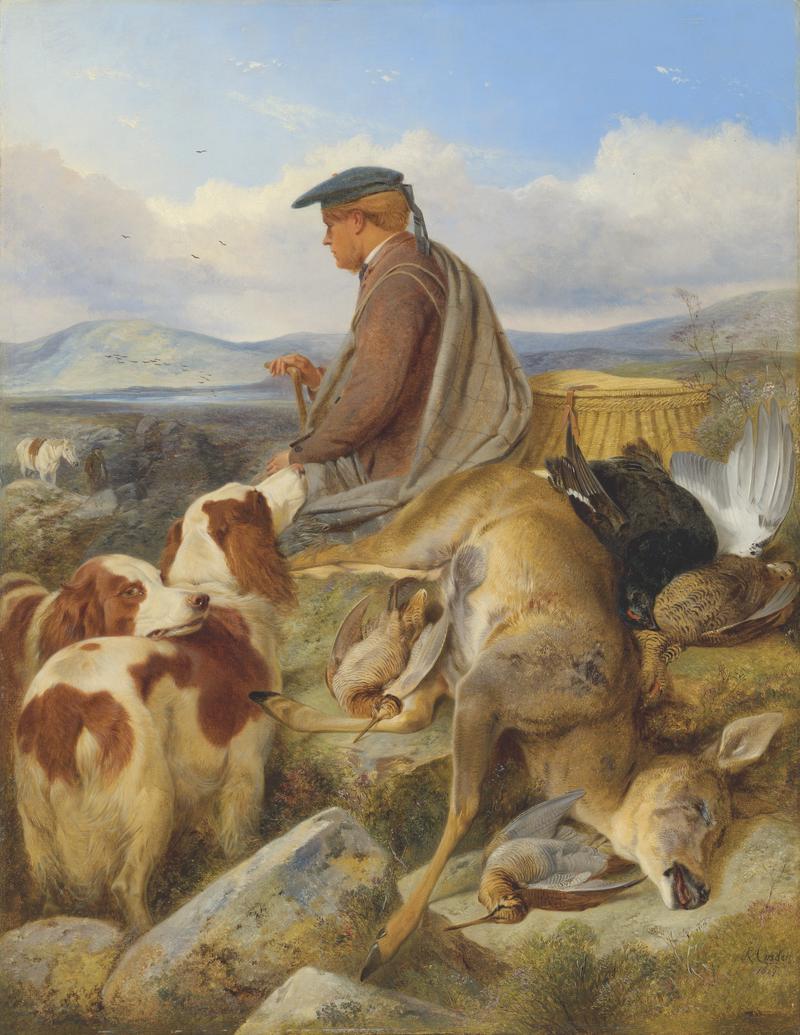A Good Day's Sport - A Gamekeeper, his Dogs and Kill

This subject matter is typical of Ansdell who injected his hunting and sporting scenes with a subtle melodrama, telling the story of the hunt in a single image. A Good Day’s Sport seems to tell of a fruitful but exhausting hunt, picturing a moment of respite after the action. Ansdell was a great lover of Scotland and each of his pictures seem an ode to the country, glorifying its traditions and landscape. He often depicted harmonic and pastoral idylls exemplified in the life of the ghillie, the shepherd and the gamekeeper. This romantic vision is set in the rugged Scottish landscape with animated studies of animals and human figures. Expert in his execution, the artist gives the animals full character and detail - the result of years studying and capturing animal forms. The close detailing of the golden-brown lichen on the rocks in the foreground, the deer’s fur and birds’ feathers and the glossy glow of the dogs’ coats are typical of Ansdell’s application.
Ansdell’s animal and rural subjects proved exceptionally popular and he was seen as the natural successor to Sir Edwin Landseer (1802-1873) and attracted the attention of wealthy aristocratic patrons. His punctilious attention to anatomical detail and the keen rendering of character without overt sentimentality, placed him in good stead to take up the torch left by one of the most popular painters in Victorian England.
It was during the 1860s that Ansdell’s love affair with Scotland began, having been introduced to the country by the Earl of Sefton whom he accompanied on shooting parties. This love of Scotland would be a constant for the rest of his life and in 1861 he built a lodge on the shores of Loch Laggan where he resided in the summer months. Interest in Scotland was a Victorian phenomenon and the subject of immense romanticizing. This can be partially attributed to Sir Walter Scott, one of the most popular writers of the day, who set many of his novels in the Highlands, and to the cultural influence of the royal family’s increasing fascination with all things Scottish. Queen Victoria made her first visit to Scotland in 1842, the itinerary of her visit planned so, ‘the greatest possible amount of rich scenery might come within range of the Royal party’ (Sir William Hooker, Perthshire illustrated: A Series of Select Views, London, Charles Tilt, 1844, p. 88) and was so captivated by the beauty of its landscapes and traditions that she purchased Balmoral Castle in 1852. The new royal interest quickly formed a vogue in Victorian society. Hunting and sport were increasingly perceived as something that fashionable society should wish to partake in. The ghillie was increasingly romanticised in art and literature and the idea of the robust highlander, living close to nature, was exulted. They inhabited a world far away from the industrialised cities in which most Victorians lived or profited from and provided something of an idealised, escapist dream.



